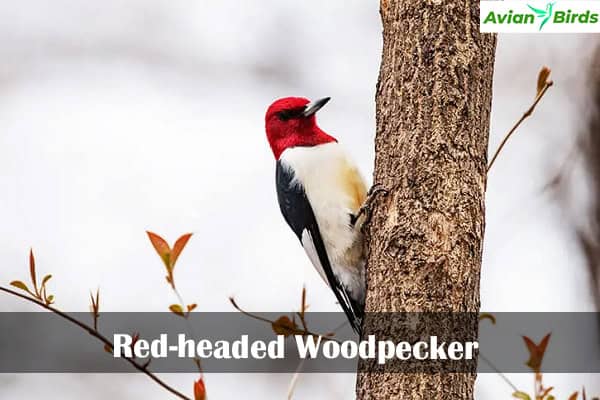Woodpeckers in Arkansas (8 Species to Know)
Did you know Arkansas has eight different types of woodpeckers? The pileated woodpecker is big, weighing 10.5 ounces, while the downy woodpecker is tiny, weighing only 0.8 ounces. This shows how diverse Arkansas bird species are. It’s key to know how to tell them apart.
This article will take you into the world of woodpeckers in Arkansas. Each species has its own special features. They add to the beauty of Arkansas wildlife. Whether you love birds or just enjoy nature, you’ll learn to spot and appreciate all eight species.
Introduction to Woodpeckers
Woodpeckers are fascinating to birdwatchers. They have interesting behaviors and look unique. These birds use strong beaks to find insects and sap in trees.
In Arkansas, there are many woodpecker species. Each one is special in its own way. You might hear a Red-headed Woodpecker drumming or see a Downy Woodpecker searching carefully.
Arkansas has eight woodpecker species. Each one has its own look and way of living. For example, Pileated Woodpeckers are big and have bright red crests.
By watching these birds, you learn about their roles in nature. They help keep the forest healthy by controlling insects and creating homes for other animals.
Learning about woodpeckers makes you appreciate them more. They have bright colors and interesting ways of nesting. Their work in the forest is vital for all living things.
The Importance of Woodpeckers in Ecosystems
Woodpeckers are key to keeping forests healthy. They control insects by digging into tree bark. This stops pests from harming trees, keeping forests strong.
Woodpeckers also make homes in trees. These homes are for owls and small mammals. This helps forests have more life and be stronger.
In Arkansas, woodpeckers are very important. Places like Warren Prairie Natural Area are being fixed for them. This helps more woodpeckers live there, which is good for the forest.
Woodpeckers in Arkansas
In Arkansas, many woodpecker types live in different places. Each one has special traits that make them stand out. These traits help them fit into Arkansas’s wildlife.
Overview of Species Diversity
Arkansas has eight main woodpecker types. Each one likes different places to live. You can find them in forests and open woods.
Some well-known woodpeckers in Arkansas are the red-bellied and downy woodpeckers. The ivory-billed woodpecker is also famous here.
Unique Characteristics of Arkansas Woodpeckers
Identifying woodpeckers in Arkansas is easier when you know their special traits. For example, the red-headed woodpecker has a bright red head and black back. The downy woodpecker is small with white belly and black spots.
The ivory-billed woodpecker is big and has a special history. It almost disappeared but is now rare again.
Knowing these traits helps bird lovers see how beautiful and diverse Arkansas woodpeckers are. Watching how they eat, nest, and act is fascinating. It shows how important they are to our ecosystem.
Size Differences among Arkansas Woodpeckers
Arkansas woodpeckers come in all shapes and sizes. This size difference affects how they eat and where they live. With 11 species, the biggest and smallest woodpeckers show how diverse they are.
Largest and Smallest Species
The pileated woodpecker is the biggest in Arkansas, growing up to 20 inches long and weighing 10.5 ounces. The downy woodpecker is the smallest, at about 6 inches long and weighing 0.8 ounces. These size differences change how they find food.
Weight and Length Comparisons
Here’s a table showing the size differences among Arkansas woodpeckers:
| Woodpecker Species | Woodpecker Length (inches) | Woodpecker Weight (ounces) |
|---|---|---|
| Pileated Woodpecker | 20 | 10.5 |
| Red-bellied Woodpecker | 9 | 3.5 |
| Red-headed Woodpecker | 9.5 | 3.5 |
| Hairy Woodpecker | 9 | 5.5 |
| Downy Woodpecker | 6 | 0.8 |
Woodpecker size affects their diet. Big ones like the pileated eat bigger insects and fruits. Small ones, like the downy, eat smaller food. Their size helps keep the ecosystem balanced.
Nesting Habits of Arkansas Woodpeckers
Woodpeckers in Arkansas have interesting nesting habits. They use unique methods to make nests in trees. This shows how they adapt to their surroundings.
Excavating Nests in Trees
Woodpeckers start by digging holes in trees. Both males and females work together. They use their strong beaks to dig.
Some woodpeckers prefer dead trees, while others like living ones. It takes them about two to three weeks to make a nest. The nest is safe from predators and close to food.
Breeding and Incubation Practices
Woodpeckers in Arkansas breed from late April to May. They usually have two to ten eggs at a time. Both parents help with incubation.
The female takes care of the eggs during the day. The male does it at night. This way, the eggs are kept warm for about nine to fourteen days.
| Woodpecker Species | Nesting Habitat | Average Clutch Size | Incubation Period (Days) |
|---|---|---|---|
| Red-bellied Woodpecker | Various, including urban areas | 3-7 | 12-14 |
| Downy Woodpecker | Wide variety of habitats | 3-8 | 12 |
| Red-cockaded Woodpecker | Old-growth living pines | 2-5 | 12-13 |
| Pileated Woodpecker | Deciduous forests | 3-5 | 15 |
| Northern Flicker | Open woodlands | 4-7 | 11-14 |
Woodpeckers’ nesting habits show their adaptability. They play a big role in ecosystems. Learning about their nesting habits helps us appreciate these birds more.
Feeding Patterns of Woodpeckers
Learning about woodpeckers’ eating habits makes birdwatching in Arkansas more fun. These birds eat different things and find food in various ways. Watching them forage shows how important they are to nature.
Dietary Preferences
Woodpeckers in Arkansas eat a wide range of foods. Most eat insects, but some like different things. Northern Flickers like to eat ants and larvae from the ground. Yellow-bellied Sapsuckers get tree sap by tapping into trees.
- Insects: Primary food source for most woodpecker species
- Tree Sap: A specialty for Yellow-bellied Sapsuckers
- Grains and Seeds: Woodpeckers also consume various seeds and grains available at feeders
Foraging Techniques and Behaviors
Woodpeckers have different ways of finding food, showing how well they adapt. Their foraging methods help us understand their role in nature. Watching them can make us appreciate nature more.
- Ground Foraging: Northern Flickers prefer to forage for insects on the ground
- Sap Wells: Sapsuckers carve out sap wells on trees, allowing them to drink sap directly
- Tree Bark Pecking: Many woodpecker species drum on tree bark to extract insects hidden beneath the surface
Common and Rare Woodpecker Species in Arkansas
Woodpeckers are key in Arkansas’s ecosystems. They come in many types, some more common than others. The red-bellied woodpecker is often seen, while the red-cockaded woodpecker is very rare and in danger.
1. Red-bellied Woodpecker: Most Common
- Scientific Name: Melanerpes carolinus
- Size: 23–25 cm (9–10 in)
- Weight: 70–100 g (2.5–3.5 oz)
- Lifespan: Up to 12 years in the wild
- Diet: Insects, fruits, nuts, and seeds
The red-bellied woodpecker is the most common bird in Arkansas. It lives in forests and cities and can be found at bird feeders, which shows that it can adapt well.

They have a long tongue that helps them get insects and sap. Their bright colours and call make them a joy to watch. They show that the ecosystem is healthy.
Must Visit: Woodpeckers in Wisconsin
2. Red-cockaded Woodpecker: Rarer
- Scientific Name: Picoides borealis
- Size: 20–23 cm (7.9–9.1 in)
- Weight: 55–100 g (1.9–3.5 oz)
- Lifespan: Up to 12 years in the wild
- Diet: Primarily insects, especially ants and beetles
The red-cockaded woodpecker is very rare in Arkansas. It’s endangered because its home, longleaf pine forests, is disappearing. Efforts are being made to save it.

Rules are in place to protect its home. But the woodpecker’s numbers keep going down. We need to keep talking about how to save it.
| Species | Status | Habitat | Notable Traits |
|---|---|---|---|
| Red-bellied Woodpecker | Common | Forests, urban areas | Long tongue, vibrant colors |
| Red-cockaded Woodpecker | Rare | Longleaf pine forests | Critically endangered, habitat-specific |
Woodpecker Species Profiles
Arkansas is home to many woodpecker species. Each one has unique traits and plays a big role in the ecosystem. Knowing about them helps us see how important they are for keeping nature balanced.
3. Yellow-bellied Sapsucker
- Scientific Name: Sphyrapicus varius
- Size: 18–22 cm (7–8.7 in)
- Weight: 50–100 g (1.8–3.5 oz)
- Lifespan: Up to 6 years in the wild
- Diet: Primarily sap from trees, along with insects and fruits
The yellow-bellied sapsucker is known for drilling holes in trees to get sap. It loves hardwood forests. This bird has a black and white body with a bright red crown.

They migrate south for the winter. This helps them avoid cold weather.
Also Read: Woodpeckers in Texas
4. Red-headed Woodpecker
- Scientific Name: Melanerpes erythrocephalus
- Size: 22–26 cm (8.7–10.2 in)
- Weight: 70–100 g (2.5–3.5 oz)
- Lifespan: Up to 9 years in the wild
- Diet: Insects, fruits, nuts, and seeds
The red-headed woodpecker stands out with its bright red head. This bird loves open woodlands and is great at controlling insects. It has a black-and-white body.

It’s also very good at climbing and finding food in trees.
5. Red-bellied Woodpecker
- Scientific Name: Melanerpes carolinus
- Size: 23–25 cm (9–10 in)
- Weight: 70–100 g (2.5–3.5 oz)
- Lifespan: Up to 12 years in the wild
- Diet: Insects, fruits, nuts, and seeds
The red-bellied woodpecker is common in Arkansas. It can live in many places, from forests to backyards. It has a red patch on its belly and a zebra-like pattern on its back.

This helps it blend in with its surroundings.
Read now: Woodpeckers Of Ohio
6. Downy Woodpecker
- Scientific Name: Picoides pubescens
- Size: 14–19 cm (5.5–7.5 in)
- Weight: 28–90 g (1–3.2 oz)
- Lifespan: Up to 10 years in the wild
- Diet: Insects, larvae, seeds, and berries.
Downy woodpeckers are small and often seen at bird feeders. They help control insect numbers. They have a black and white body and a short bill.

This makes them different from the hairy woodpecker.
7. Hairy Woodpecker
- Scientific Name: Picoides villosus
- Size: 20–23 cm (7.9–9.1 in)
- Weight: 70–100 g (2.5–3.5 oz)
- Lifespan: Up to 15 years in the wild
- Diet: Insects, especially wood-boring beetles
The hairy woodpecker looks similar to the downy but is bigger. It prefers older forests. It has a long bill and makes loud drumming sounds.

This helps it find a mate and keep forests healthy.
You must read: Woodpeckers in Montana
8. Pileated Woodpecker
- Scientific Name: Dryocopus pileatus
- Size: 38–49 cm (15–19 in)
- Weight: 250–400 g (8.8–14.1 oz)
- Lifespan: Up to 12 years in the wild
- Diet: Primarily wood-boring insects
The pileated woodpecker is the biggest in North America. It looks like a crow. It makes big holes in trees to find insects.

Also, It has a red crest and a loud call. It likes mature forests for nesting.
9. Northern Flicker
- Scientific Name: Colaptes auratus
- Size: 30–36 cm (12–14 in)
- Weight: 90–150 g (3.2–5.3 oz)
- Lifespan: Up to 9 years in the wild
- Diet: Primarily ants and beetles, along with seeds and fruits
The northern flicker is known for foraging on the ground. It migrates and eats ants and beetles. It has a black-spotted belly and a nice call in spring.

These traits make it fun to watch.
Also read: Woodpeckers in Missouri
10. Red-cockaded Woodpecker
- Scientific Name: Picoides borealis
- Size: 20–23 cm (7.9–9.1 in)
- Weight: 55–100 g (1.9–3.5 oz)
- Lifespan: Up to 12 years in the wild
- Diet: Primarily insects, especially ants and beetles, along with some seeds and fruits.
The red-cockaded woodpecker nests in living pine trees. It is endangered and needs large pines in old forests to survive.

Sounds and Calls of Arkansas Woodpeckers
Woodpeckers are fascinating birds with interesting sounds. Learning their calls can help you enjoy watching them. Their sounds help them find mates and mark their territory.
Identifying Species by Sound
Every woodpecker has its own call and drumming style. For example, the Downy Woodpecker makes a whinnying sound for about two seconds. Listening for these sounds can help you spot Arkansas woodpeckers more easily.
They also drum loudly, which is key for talking to each other. This drumming is not just for fun but for serious communication.
Unique Vocalizations
Woodpeckers make a range of sounds and patterns. Drumming is a fast pecking that sounds like one long note. It helps them find mates and mark their territory.
The rhythm and speed of drumming differ among species. Some drum on trees, while others prefer poles or even gutters. Their calls may not have melodies, but they are still unique. They use these sounds to warn others or talk to their mates.
Knowing about woodpecker sounds helps us understand and appreciate them more. Groups like the American Bird Conservancy work to save woodpecker homes, which is important because their habitats are being lost.
Read More🐦Related Articles:
| Barn Swallow: Everything You Need To Know |
| Doves in Kansas |
| Greater White-Fronted Goose: Facts & Habitat |
| Bar-Headed Goose: High-Flying Himalayan Marvel |
| Woodpeckers in Wisconsin |
Conclusion
Woodpeckers in Arkansas include a wide range of species, each playing a key role in the ecosystem. They help their habitats in many ways, like nesting and foraging.
Their presence, especially the Red-cockaded Woodpecker, highlights Arkansas’s ecological beauty. It shows why we must protect woodpeckers. With about 100-120 active colonies, your help matters a lot.
Learning about these birds makes us want to save them even more. The story of the Ivory-billed Woodpecker is a reminder of the need to protect habitats. Birdwatching and spreading the word can help protect these birds.
By being aware and taking action, we can ensure that woodpeckers in Arkansas continue to thrive, which will benefit future generations.







